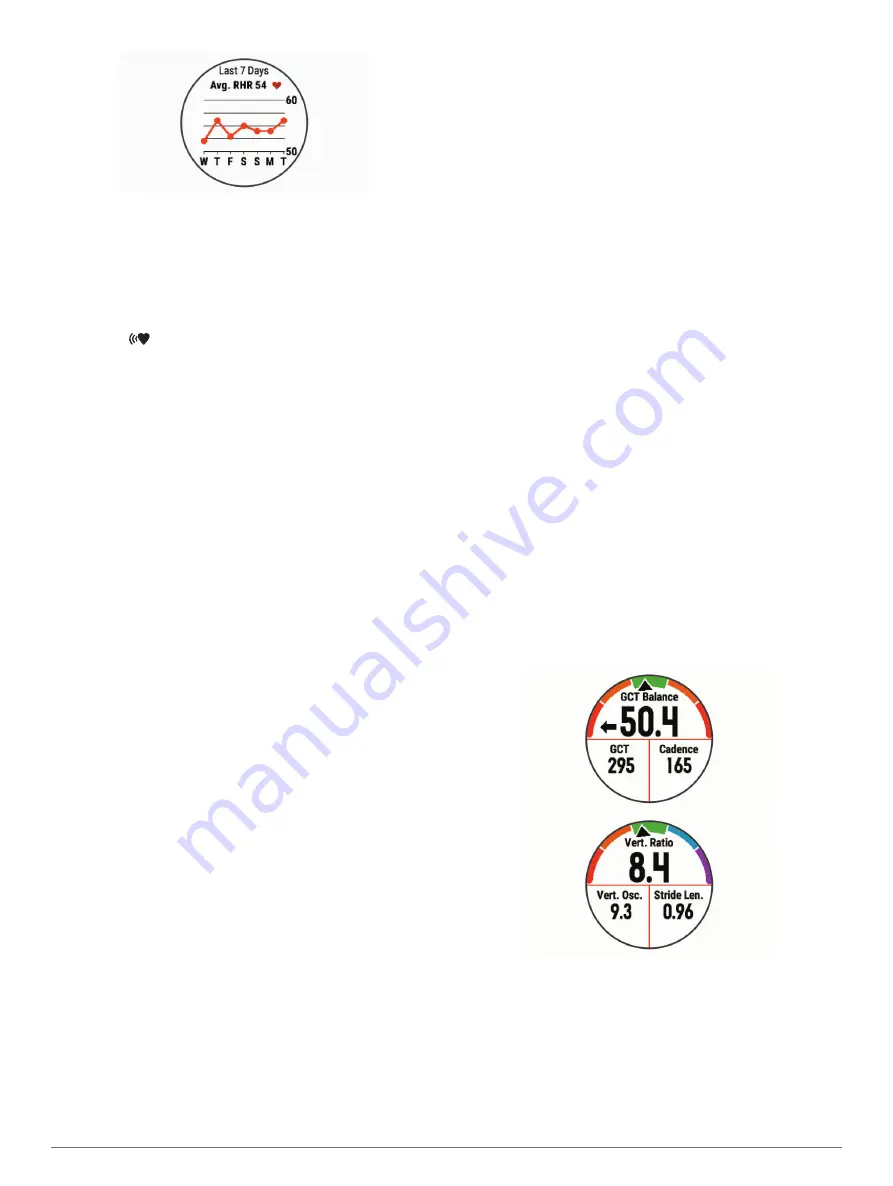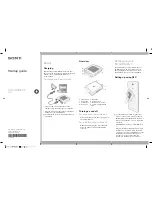
Broadcasting Heart Rate Data to Garmin
®
Devices
You can broadcast your heart rate data from your Forerunner
device and view it on paired Garmin devices.
NOTE:
Broadcasting heart rate data decreases battery life.
1
From the heart rate widget, hold
UP
.
2
Select
Options
>
Broadcast Heart Rate
.
The Forerunner device starts broadcasting your heart rate
data, and
appears.
NOTE:
You can view only the heart rate widget while
broadcasting heart rate data from the heart rate widget.
3
Pair your Forerunner device with your Garmin ANT+
compatible device.
NOTE:
The pairing instructions differ for each Garmin
compatible device. See your owner's manual.
TIP:
To stop broadcasting your heart rate data, select any
key, and select Yes.
Broadcasting Heart Rate Data During an Activity
You can set up your Forerunner device to broadcast your heart
rate data automatically when you begin an activity. For example,
you can broadcast your heart rate data to an Edge
®
device while
cycling, or to a VIRB action camera during an activity.
NOTE:
Broadcasting heart rate data decreases battery life.
1
From the heart rate widget, hold
UP
.
2
Select
Options
>
Broadcast During Activity
.
3
Begin an activity (
).
The Forerunner device starts broadcasting your heart rate
data in the background.
NOTE:
There is no indication that the device is broadcasting
your heart rate data during an activity.
4
If necessary, pair your Forerunner device with your Garmin
ANT+ compatible device.
NOTE:
The pairing instructions differ for each Garmin
compatible device. See your owner's manual.
TIP:
To stop broadcasting your heart rate data, stop the
activity (
).
Turning Off the Wrist Heart Rate Monitor
The default value for the Wrist Heart Rate setting is Auto. The
device automatically uses the wrist-based heart rate monitor
unless you pair an ANT+ heart rate monitor to the device.
1
From the heart rate widget, hold
UP
.
2
Select
Options
>
Status
>
Off
.
Running Dynamics
You can use your compatible Forerunner device paired with the
HRM-Run
™
accessory or other running dynamics accessory to
provide real-time feedback about your running form. If your
Forerunner device was packaged with the HRM-Run accessory,
the devices are already paired.
The running dynamics accessory has an accelerometer that
measures torso movement in order to calculate six running
metrics.
Cadence
: Cadence is the number of steps per minute. It
displays the total steps (right and left combined).
Vertical oscillation
: Vertical oscillation is your bounce while
running. It displays the vertical motion of your torso,
measured in centimeters.
Ground contact time
: Ground contact time is the amount of
time in each step that you spend on the ground while
running. It is measured in milliseconds.
NOTE:
Ground contact time and balance are not available
while walking.
Ground contact time balance
: Ground contact time balance
displays the left/right balance of your ground contact time
while running. It displays a percentage. For example, 53.2
with an arrow pointing left or right.
Stride length
: Stride length is the length of your stride from one
footfall to the next. It is measured in meters.
Vertical ratio
: Vertical ratio is the ratio of vertical oscillation to
stride length. It displays a percentage. A lower number
typically indicates better running form.
Training with Running Dynamics
Before you can view running dynamics, you must put on the
HRM-Run accessory, HRM-Tri
™
accessory, or Running
Dynamics Pod, and pair it with your device (
).
If your Forerunner was packaged with the heart rate monitor, the
devices are already paired, and the Forerunner is set to display
running dynamics.
1
Select
START
, and select a running activity.
2
Select
START
.
3
Go for a run.
4
Scroll to the running dynamics screens to view your metrics.
5
If necessary, hold
UP
to edit how the running dynamics data
appears.
Color Gauges and Running Dynamics Data
The running dynamics screens display a color gauge for the primary metric. You can display cadence, vertical oscillation, ground
contact time, ground contact time balance, or vertical ratio as the primary metric. The color gauge shows you how your running
dynamics data compare to those of other runners. The color zones are based on percentiles.
Garmin has researched many runners of all different levels. The data values in the red or orange zones are typical for less
experienced or slower runners. The data values in the green, blue, or purple zones are typical for more experienced or faster
Heart Rate Features
9
Содержание FORERUNNER 645
Страница 1: ...FORERUNNER 645 645MUSIC Owner sManual ...
Страница 36: ...Z zones heart rate 7 time 23 32 Index ...
Страница 37: ......
Страница 38: ...support garmin com February 2018 190 02324 00_0B ...














































